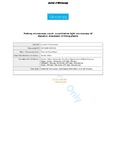Making microscopy count: quantitative light microscopy of dynamic processes in living plants
| dc.contributor.author | FRICKER, MARKD | |
| dc.contributor.author | MOGER, JULIAN | |
| dc.contributor.author | Littlejohn, George | |
| dc.contributor.author | DEEKS, MICHAELJ | |
| dc.date.accessioned | 2017-05-24T19:04:02Z | |
| dc.date.available | 2017-05-24T19:04:02Z | |
| dc.date.issued | 2016-08 | |
| dc.identifier.issn | 0022-2720 | |
| dc.identifier.issn | 1365-2818 | |
| dc.identifier.uri | http://hdl.handle.net/10026.1/9336 | |
| dc.description.abstract |
<jats:title>Summary</jats:title><jats:p>Cell theory has officially reached 350 years of age as the first use of the word ‘cell’ in a biological context can be traced to a description of plant material by Robert Hooke in his historic publication ‘Micrographia: or some physiological definitions of minute bodies’. The 2015 Royal Microscopical Society Botanical Microscopy meeting was a celebration of the streams of investigation initiated by Hooke to understand at the subcellular scale how plant cell function and form arises. Much of the work presented, and Honorary Fellowships awarded, reflected the advanced application of bioimaging informatics to extract quantitative data from micrographs that reveal dynamic molecular processes driving cell growth and physiology. The field has progressed from collecting many pixels in multiple modes to associating these measurements with objects or features that are meaningful biologically. The additional complexity involves object identification that draws on a different type of expertise from computer science and statistics that is often impenetrable to biologists. There are many useful tools and approaches being developed, but we now need more interdisciplinary exchange to use them effectively. In this review we show how this quiet revolution has provided tools available to any personal computer user. We also discuss the oft‐neglected issue of quantifying algorithm robustness and the exciting possibilities offered through the integration of physiological information generated by biosensors with object detection and tracking.</jats:p> | |
| dc.format.extent | 181-191 | |
| dc.format.medium | Print-Electronic | |
| dc.language | en | |
| dc.language.iso | en | |
| dc.publisher | Wiley | |
| dc.subject | Bioimaging informatics | |
| dc.subject | botanical microscopy | |
| dc.subject | live-cell imaging | |
| dc.title | Making microscopy count: quantitative light microscopy of dynamic processes in living plants | |
| dc.type | journal-article | |
| dc.type | Journal Article | |
| dc.type | Research Support, Non-U.S. Gov't | |
| dc.type | Review | |
| plymouth.author-url | https://www.webofscience.com/api/gateway?GWVersion=2&SrcApp=PARTNER_APP&SrcAuth=LinksAMR&KeyUT=WOS:000379967600008&DestLinkType=FullRecord&DestApp=ALL_WOS&UsrCustomerID=11bb513d99f797142bcfeffcc58ea008 | |
| plymouth.issue | 2 | |
| plymouth.volume | 263 | |
| plymouth.publication-status | Published | |
| plymouth.journal | Journal of Microscopy | |
| dc.identifier.doi | 10.1111/jmi.12403 | |
| plymouth.organisational-group | /Plymouth | |
| plymouth.organisational-group | /Plymouth/Faculty of Science and Engineering | |
| plymouth.organisational-group | /Plymouth/Faculty of Science and Engineering/School of Biological and Marine Sciences | |
| plymouth.organisational-group | /Plymouth/REF 2021 Researchers by UoA | |
| plymouth.organisational-group | /Plymouth/REF 2021 Researchers by UoA/UoA06 Agriculture, Veterinary and Food Science | |
| plymouth.organisational-group | /Plymouth/Users by role | |
| plymouth.organisational-group | /Plymouth/Users by role/Academics | |
| dc.publisher.place | England | |
| dcterms.dateAccepted | 2016-02-16 | |
| dc.identifier.eissn | 1365-2818 | |
| dc.rights.embargoperiod | Not known | |
| rioxxterms.versionofrecord | 10.1111/jmi.12403 | |
| rioxxterms.licenseref.uri | http://www.rioxx.net/licenses/all-rights-reserved | |
| rioxxterms.licenseref.startdate | 2016-08 | |
| rioxxterms.type | Journal Article/Review |


